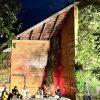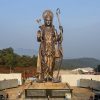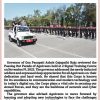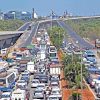Goa is abuzz with excitement as vintage bike and car owners, users, collectors and fans are decking […]
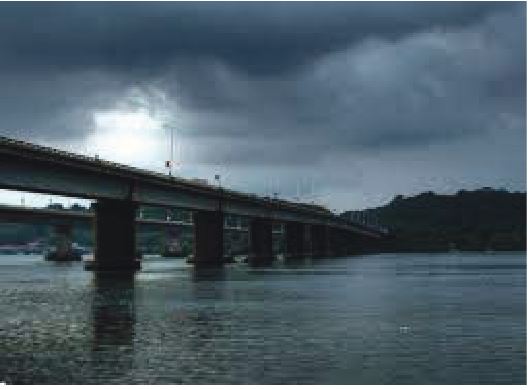
MANDOVI THREATENED BY DIVERSION & DAMS!By Rajendra P Kerker
Jan 07- Jan 13 2023 January 6, 2023THREAT: Barge traffic up and down the rivers Mandovi and its major tributaries is crucial for iron ore transportation and this will be severely affected by any diversion of the headwaters of the Mhadei river source in Karnataka Western Ghats hills…
By Rajendra P Kerker
Noted environmentalist and deputy chairperson of the Goa Bachao Abhiyan, Rajendra P Kerker, first dramatized the consequences of any diversion of the headwaters of the Mhadei river in Karnataka, in this article published in the Goa Heritage Action Group’s “Parmal” journal, issue dated December 2008. Kerkar puts into perspective the contemporary history of how riverine stories get vitiated with time and this is the story of how one state seeks to exploit river waters which rightfully belong to another state… goanobserver.in reproduces the article here so that people and today’s activists visualize how changing a river’s natural route – in this case the Mhadei — will impact Goa’s lifeline river, the Mandovi. A river may be used and abused to reap long-term disaster all around in the future. There is no time to lose to stop Karnataka from carrying out its ruthless intentions for it is wrong both morally and legally.
GOA is blessed by eleven rivers, of which the Mandovi is the longest. Though not as long as the Ganga (which is about 2,525km) or as the Cauvery (which is 760km) the 87km long River Mandovi or Mhadei, during an area of about 1,580 sq km of the 3,701 sq km geographical area of Goa and provides a large quantity of fresh water. It is indeed as river that supports life and above all, makes life possible for all living things. It is the artery of the watershed, which supplies the nutrients necessary for the body to survive. A river, when flowing through its natural course, benefits all irrespective of caste, creed, colour or class, but as soon as it is dammed it loses its social character.
For the last three decades , Karnataka has been very keen to build dams on the various tributaries of the river Mhadei originating from that state, both for generating hydro-electricity and for irrigation. In September 2006, the Karnataka government , claiming drinking water paucity for Hubli and Dharward, unilaterally went ahead and excavated canals in Kankumbi for the Kalasa-Bhandura project which aims to drivert 7.56 thousand million cubic feet (TMC ft) of water into the Malaprabha basin. The government of Goa strongly objected to all the proposals to dam and divert the tributaries of the Mhadei on economic, ecological and environmental grounds, especially from the point of view of our tiny state’s water and ecological security. When all the attempts to arrive at an amicable solution proved futile and Karnataka was adamant about its plans. Goa approached the Supreme Court of India for justice and is awaiting its final verdicts.
Karnataka’s grand plan is to divert a total of 225 thousand circular mils (MCM)of water from the Mhadei into the Malaprabha basin and an additional 112 MCM from the Khandepar river, which is popular for the scenic Dudhsagar waterfall, into the Supa reservoir in the Kali basin. Karnataka’s thirst for water cannot be quenched with the Kalasa- Bhandura project and indeed will only increase.
The Mandovi river basin in Goa occupies 43% of the state’s geographical area. It holds 192 villages spread over Sattari, Sanguem, Bicholim, Tiswadi, Bardez and Ponda with Cultivable land of 91,072 hectares (ha). The Mhadei is the most important tributary of the Mandovi and originates in Degao near Khanapur. At Nerse village, where the three main tributaries-Singer, Pat and Bandhura-join together Karnataka has proposed an earthen dam, the reservoir of which will submerge 244 hectares of forest land. The diversion channel also will involve the non-forest use of sixteen hectares of forest land. According to the observations made by the Deputy Conservator of Forests of Karnataka, the proposed dam site of Bhandura is located among the most luxurious and moist-deciduous and semi-evergreen patches of forest frequented by wildlife. The Bhandura nalla (canal) is a perennial stream which joins the Mhadei at Kongla and then enters Goa via Gavali-Krishnapur in Bondir along with the Panshira of Mendil. Near DhaveUste, where the Kalasa stream joins the Mhadei, the locals still practice the traditional silt-based cultivation called puran sheti, which is believed to give three times more yield than other types of agriculture.
MHADEI WILDLIFE SANCTUARY
KARNATAKA proposes to build the Kalasa dam in Kambar Ves on the Chorla Ghat- Belgaum road near Kankumbi, which is barely one kilometre away from the Mhadei wildlife sanctuary in Goa. The Kalasa dam has a height of 32.6m and a length of 340 meters. Another dam which is planned on the Haltara nalla at Chorla is 33.6m high and 200 meters long. From the Haltara, water will be brought to the Kalasa reservoir through an open cut channel 1,180m in length and from the Kalasa, water will be taken to the Malaprabha by excavating an open-cut tunnel of 2,550m and a channel of 1,740m. In all, 178.43 ha of reserved forest in Kankumbi, 14.58 ha in Parwad and 64.73 ha in Koda will be affected by the diversion. It is therefore clear that forest land is an integral part of those projects and is required not only for the construction of the dam and the resultant submergence area but also for the diversion channels.
According to the guidelines issued under the Forest Conservation Act 1980, it was decided that if a project involves forest as well as non-forest land, work should not be started on the non-forest land till the approval of the Central Government for the release of forest land. To date, Karnataka has not received the forest clearance from the Ministry of Environment and Forests, and the Ministry of Water Resources has not withdrawn the in-principle clearance which was placed in abeyance in September 2002. Thus, the two states have so far not concluded any agreement on the sharing of the Mhadei waters. Goa has already requested the Union Government to set up a tribunal as per the interstate water disputes act, of 1956. However, despite Goa’s serious objections, Karnataka went ahead with the proposal. This is a classic instance of the breakdown of environmental governance and constitutional provisions for the protection of the environment. The 7.56 TMC feet of water that is being undemocratically and illegally diverted is no small quantity that the hydrological budget or the ecosystem of a large basin will certainly be disturbed.
BUILDING DAMS
KARNATAKA has made it very clear that it is building dams and not bundharas. The construction of bundharas is entirely different from that of dams. How can one designate a dam as a bundhara when it involves the submergence of the pristine forest lands! The length and height of these dams and their capacity to store water clearly indicate that these projects are not bundharas but earthen dams. The Water Resources Department of Goa has already built more than a dozen bundharas on various tributaries of the Mhadei and there exist many lift irrigation schemes. Water treatment plants in Dabos cater to the drinking water needs of 52 villages of Sattari, whereas those in Sanquelim and Padoshe provide potable water to many areas of Bicholim and Bardez. In April 2002, the Goa government announced that it was considering a set of smaller dams to generate a total of 60MW of Goa’s power needs.
The Goa government has in the past been denied permission by the Ministry of Environment & Forests to build the Mandovi irrigation project in Nanoda, in Sattari, on the grounds that it would destroy 350 hectares of forest, when Goa had already spent a total of Rs210.96 lakh on the construction of colonies and other infrastructure.
At present, Karnataka is going ahead to meet the same fate under the Forest Conservation Act. Karnataka’s proposal will cause massive disturbances to the habitat of wildlife in the Mhadei valley. When dams and developmental activities increased in and around the Dandeli wildlife sanctuary, elephants from these areas began to migrate. Today, the Tillari and Mhadei valleys are badly affected on account of man-elephant conflicts.
KARNATAKA’S MISMANAGEMENT
THE report of high-level committee to suggest appropriate water management strategies for Karnataka state irrigation projects, March 1999, highlighted Karnataka’s mismanagement of its water resources. Farmers in Karnataka are raising crops according to their wishes, violating the prescribed cropping pattern, due to which it has become difficult to distribute water equitably to all parts of the command area. Adding to the water shortage are the leakages in the pipeline supplying water to Hubli-Dharwad town. Anticipating problems if the diversion project is linked to the demand for irrigation. Karnataka has invoked the need for a supply of drinking water, aware of the top priority given to it in India’s National Water Policy. The project cost was also trimmed to bring in below Rs 1,000 million to avoid the mandatory environmental impact assessment and public hearing.
Considering the projected water needs of Goa until 2050 AD, it has been established by a committee of experts that Mhadei is a water-deficit basin and hence there is no scope for water diversion. Goans are very concerned that any diversions of water from the upper catchments of the Mhadei would severely impact the downstream ecology, particularly by changes in the salinity regime, a decrease in sediment load and its consequent impact on the estuarine and mangrove ecosystems. The controversial project site is home to natural forest, unique wildlife and river sources and the biggest catchments for the Mhadei and Malaprabha rivers.
At present, India is experiencing a change in the pattern of monsoon rain. For example, the Goan town of Vasco, which is close to the sea, received 2,798mm of rain in 1959 and 2,111mm in 2004. Margao, four km away from the sea, received 3,322mm rainfall in 1959 and 2,311mm in 2004. Moving toward the interior, we find that rainfall figures for Pernem, located 11kms from the sea, were 3,493mm and 2,247mm. Moving closer to the Western Ghats, the orographic (mountain-related) influence is easily discerned. Valpoi town is 32 km away from the sea and received 5,571mm of rainfall in 1959 and 3,316mm in 2004. Lastly, we can compare the figures for Sanguem, at the foot of the Western Ghats. It received 6,333mm in 1959 and just 2,913 in 2004. The South-West monsoon in the 21st century has proved to be less productive for Goa.
CONSUMER CULTURE
RECENTLY, the Maharashtra government has also entered the race to acquire the freshwater resources of the Mhadei. One of the significant rivulets of the Mhadei coming from Virdi village has become a target of Maharashtra’s damming plan. In Virdi, just three km from Anjunem irrigation project of Keri-Sattari, Maharashtra has begun work on an irrigation project of 600 mtrs height in between Temb and Talyachya Vhalacho Dongor area. Without understanding the actual situation and signing the memorandum of understanding for its share of water, the Goa government has given its consent, which is totally irresponsible and will result in a big catastrophe.
The colonial mentality has produced a “consumer culture,” resulting in the felling of forests causing landslides and affecting nature’s capacity to conserve water. This consumer culture has led to the erosion of natural sources of livelihood resulting in the loss of humane sensitivity which has made the crisis of nature and ecology more complicated. The new goal of science should be to develop a harmonious relationship with nature. To maintain the natural equilibrium, it is essential to keep in mind the preservation of other flora and fauna of the basin.







